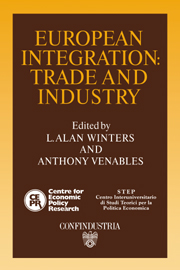Book contents
- Frontmatter
- Contents
- List of figures
- List of tables
- Preface
- Acknowledgements
- List of conference participants
- 1 European integration: trade and industry
- 2 Completing the internal market in the EC: factor demands and comparative advantage
- Discussion
- 3 External effects and Europe's integration
- Discussion
- 4 The quality and production of textiles and clothing and the completion of the internal market
- Discussion
- 5 Competition and imports in the European market
- Discussion
- 6 The structure and determinants of East–West trade: a preliminary analysis of the manufacturing sector
- Discussion
- 7 1992 and EFTA
- Discussion
- 8 Technology policy in the completed European market
- Discussion
- 9 Corporation tax, foreign direct investment and the single market
- Discussion
- 10 Japanese direct manufacturing investment in Europe
- Discussion
- Index
10 - Japanese direct manufacturing investment in Europe
Published online by Cambridge University Press: 07 September 2010
- Frontmatter
- Contents
- List of figures
- List of tables
- Preface
- Acknowledgements
- List of conference participants
- 1 European integration: trade and industry
- 2 Completing the internal market in the EC: factor demands and comparative advantage
- Discussion
- 3 External effects and Europe's integration
- Discussion
- 4 The quality and production of textiles and clothing and the completion of the internal market
- Discussion
- 5 Competition and imports in the European market
- Discussion
- 6 The structure and determinants of East–West trade: a preliminary analysis of the manufacturing sector
- Discussion
- 7 1992 and EFTA
- Discussion
- 8 Technology policy in the completed European market
- Discussion
- 9 Corporation tax, foreign direct investment and the single market
- Discussion
- 10 Japanese direct manufacturing investment in Europe
- Discussion
- Index
Summary
The basic facts
Japanese direct investment in advanced countries is a relatively recent phenomenon, but an impressive acceleration has taken place since 1985. Investment in western Europe expanded gradually during the second half of the 1970s and the early 1980s and picked up sharply after 1986 (Figure 10.1). Investment has been mostly in finance (banking and insurance), services, and real estate, with industrial investment representing less than 10% of yearly flows in the 1970s, rising to 12–13% in the early 1980s and to some 20% towards the end of that decade.
The growing Japanese presence in manufacturing has attracted much attention and has been a source of debate and controversy within the EC: a quick look at the data in Table 10.1 can help focus the nature of the problem.
The Japanese presence in Europe is still quite small. It is small as a share of total Japanese investment abroad: Europe represents only about 16% of the total, running well behind North America (40% of the total), Asia (23%) and Latin America (19%). Even smaller, comparatively, is the share of manufacturing: only 10% of total investment in Europe, compared with 48% of the total going to manufacturing in North America, 38% in Asia and 24% in Latin America (Watanabe, 1988).
It is small, too, if compared with other foreign presences in European countries. For instance, according to some estimates by EUROSTAT, intra-EC direct investment amounted in 1980–6 to about 35 billion dollars, and US investment in Europe was 46 billion dollars in 1982–7 (out of which over 60% was in manufacturing).
- Type
- Chapter
- Information
- European IntegrationTrade and Industry, pp. 200 - 231Publisher: Cambridge University PressPrint publication year: 1991
- 4
- Cited by



